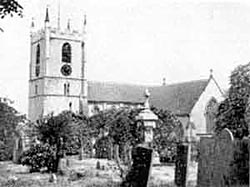< Previous | Contents | Next >
Hucknall church
 |
EXCEPT as an excellent example of the development of a rural village church to keep pace with the needs of a community changing from a quiet agricultural people into a busy centre of industry, the church of St. Mary Magdaline at Hucknall is not particularly interesting, and probably its fame would have been circumscribed had it not been for the fact that for generations it has been the burying place of the Byrons.
As it is Hucknall Church enjoys a widespread fame and attracts visitors from all parts of the world to visit the grave of the poet.
A fierce light is thrown upon the Byrons by the fame of George Gordon Byron, sixth Lord Byron of Rochdale, who was born in London on 22 January, 1788. His childhood was not a happy one, for his father was not a very desirable individual, and he would probably have made his wife, Catharine Gordon, miserable if she had not been at least as difficult as was her husband.
In these unhappy circumstances the boy was born, and spent his early years, mostly passing his time in Aberdeen. In 1801 Mrs. Byron, who was then fortunately a widow, sent him to Harrow from whence he proceeded, in 1805, to Trinity College, Cambridge. About this time he began to be interested in poetry, and in 1807 he published "Hours of Idleness," which has been described as "the worst book ever published by a considerable poet."
His "Childe Harold" appeared in 1812, and brought him fame and a certain amount of money, and it was followed by other publications which made him the darling of Society.
In 1815 he married Anne Isabella Milbanke, and his daughter Ada was born at the end of the year. But the marriage was not a happy one, and in 1816 the pair parted for ever.
Byron’s unconventional mode of life, to put it in a charitable way, had wrecked his welcome in Society, and so he left England for ever, wandering about the Continent and living a life of a distinctly Bohemian character.
In 1823 he set out to join in the movement for the liberation of Greece, and at last in 1824 he landed at Missolonghi, where he died from rheumatic fever on 19 April of that year. His body was brought home to England, and was interred with pomp and circumstance in Hucknall Church on 16 July, 1824.
